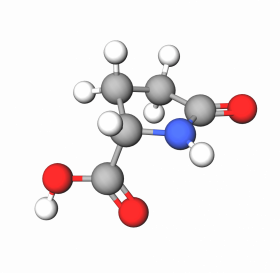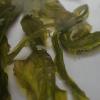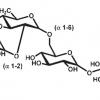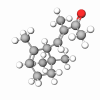Sodium PCA is contained abundantly in the skin and plays the role of a "natural moisturizing factor" (NMF) ingredient. It is extremely hygroscopic and imparts a pleasant moist feeling to skin and hair. The sodium salt, as opposed to the Pyrrolidone Carboxylic acid, is soluble in water and is used in cosmetics for this very reason.
Sodium PCA increases the softness and elasticity of skin and hair. Even in high concentrations, it is safe for the skin.
It is colorless, odorless, and is soluble in water, insoluble in mineral oil, soluble in ethanol, and insoluble in isopropylene. Sodium PCA is stable at a broad range of temperatures and pHs. It is rapidly biodegradable.
It is used in skin care products: creams, lotions, tonics, shower gels, etc.; hair care products: shampoos, conditioners, hair tonics, hair creams, etc.; sun care products: pre and post-sun care creams, lotions, gels, etc. and make-up products: foundations, lipsticks, etc. The solution is a clear liquid and is typically used at 1-4%.In cosmetic practice, Sodium PCA is well known that to keep the skin beautiful and healthy it is necessary to keep it constantly in the right state of hydration. If this state is altered it’s fundamental to restore and maintain it. For this reason, the active hydrating principles are the object of interest.
Sodium PCA a widely used ingredient thanks to its exceptionally high hydrating factor: Carboxylic pyrrolidone acid. It can be found everywhere in the body (blood, brain, kidneys, urine, plasma, etc.) even if only in micro-moli doses and with different concentrations depending on its location.
Its presence comes in massive quantities (together with the sodium salt) in the skin’s superficial protective layer, on the horny layer known as the cutaneous hydrolipidic film. This hydrolipidic mix is responsible for maintaining the right degree of skin hydration, as everybody knows. In particular, Sodium PCA’s the fraction found in the watery phase of the mix, made of hydrosoluble and hygroscopic substances, that causes this restoration and maintenance of skin moisture.
Properties and Uses
Its high water retention capacity is one of the most important biological functions carried out by this molecule. In proving this point, simply comparing this capacity with the water retention percentage of some well-known wetting agents largely used in cosmetics is adequate.A solution at 50% Sodium PCA is capable of absorbing a quantity of water 50% superior to glycerine, double compared to propylene glycol, and six times more than sorbitol (see related graph on the side). Sodium salt is often used in the cosmetic mix especially when the objective is to create a product with a high hydrating and emollient action and in particular in anti-ageing products.
It can be used in emulsion form (all kinds of creams and cosmetic milks) but also in lotions, gels, face masks, makeup products (i.e. lipsticks, foundation creams) massive dose phials, pharmaceuticals for various topical use, etc. It’s important, when making the emulsions, to add the product in the watery phase so that it will blend immediately.











